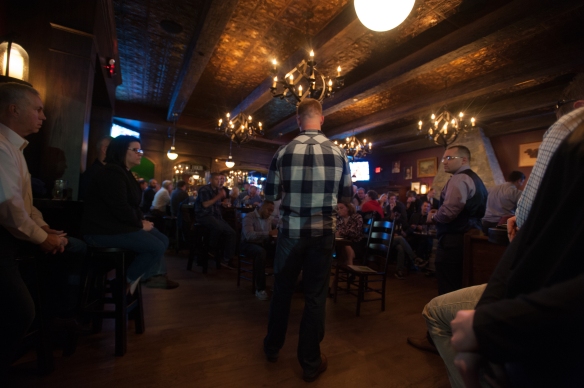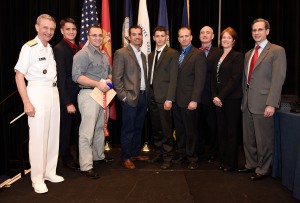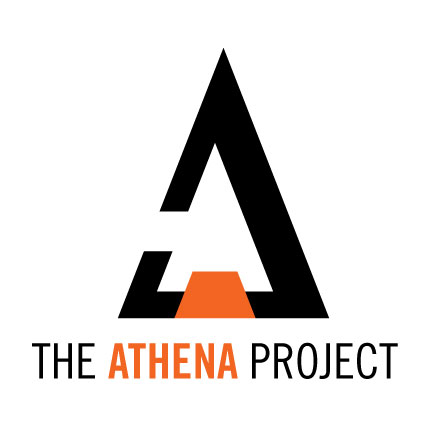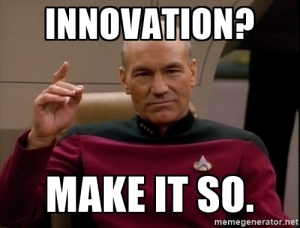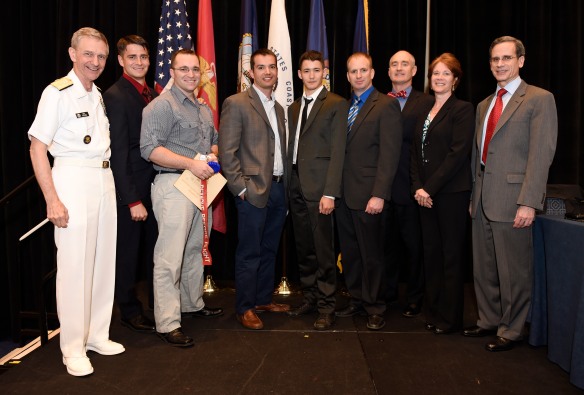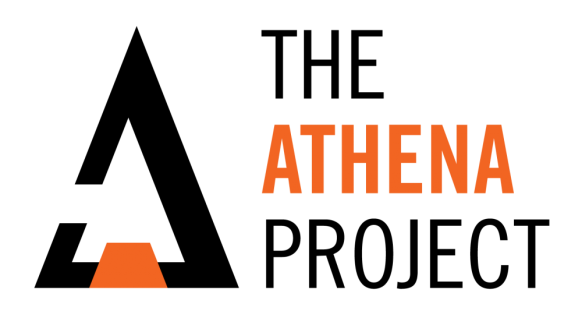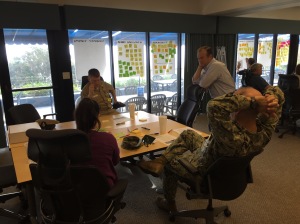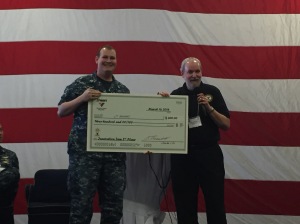By: ENS Tom Baker

We hosted our seventh Waterfront Athena gathering at Mike Hess Brewery Tasting Room in San Diego’s North Park on Friday April 24th for another incredible presentation of talent from twelve of our Fleet sailors.
It was wonderful to see our reliable contingent of SPAWAR engineers, several professors from local universities, and local business colleagues from our excellent network! To kick off the event, we were welcomed by VADM Philip Cullom, Deputy CNO for Fleet Readiness & Logistics, who delivered an encouraging message to over 70 attendees via Facetime from Washington!
A snapshot of our innovators:
*** The Waterfront Athena Seven Admiral Sims Award for Intellectual Courage***
“P&D Line Optimization″ – STG2 Richard Coronado, USS BENFOLD

During Underway Replenishments, up to 15 sailors are employed specifically to handle the Phone and Distance (P&D) line, a critical navigation tool when two ships are separated by a mere 180 feet of water. The team on deck performs minuscule adjustments to keep the line between two ships tight for for up to two hours. Necessary for the team driving the ship on the bridge, the P&D team’s job is a taxing feat, unless you leverage existing technology…
STG2 Coronado envisions two prototypes – One mechanical, and one laser-based.
The first idea is a mechanical system that will be used to hold tension on the P&D line instead of 12 sailors. This method would require a shot line to be sent over to the refueling ship, and the P&D line to be hauled over as it currently is. However, it would be held under tension by a mechanical system instead of sailors.
As STG3 Coronado explains, “We would feed the P&D line around a pulley, attach it to a bungee, and attach that bungee to a climbing rope or similar that would be passed through a climbing grigri (belaying device) or similar locking device that is anchored to a bit or other extremely strong fitting already in place on the forecastle. This would require one or two extra fittings to be welded somewhere on the forecastle for the P&D line to be guided through. This would require one person to monitor the overall tension being held by the bungee cord, and adjust slack at the locking devices anchor point.”
Coronado’s alternative is to use a laser-type rangefinder that can be placed on the side of the ship to display the distance of the nearest object (the other ship). This information could then be transmitted to a display screen on the bridge that will give the conning officer a digital number indicating the actual distance between ships.
The crowd was certainly impressed with the detailed descriptions and multiple possibilities to improve our P&D line, and our Admiral Sims award winner was already caught topside trying to find a way to rig a prototype!
“Zebra Chips″ – OS1 Victoria Shearer , USS BENFOLD

Petty Officer Shearer developed her idea in response to frustration that she noticed as her ship navigates the Surface Navy’s training cycle. She noted specifically wasted man hours training Sailors to set enhanced material condition on the ship, Zebra, to mitigate against casualties such as flooding or fires in shipboard spaces.
“We spend approximately 60 man hours per scenario for setting and verifying the proper setting of condition Zebra! My solution is a time-saving implementation,” Shearer said.
In her concept, an existing technology, called a piezoresistive pressurized chip, could execute in seconds what takes an entire ship almost an hour. When installed on hatches and scuttles, this chip allows an indication to read from the ship’s Central Control Station that the appropriate material condition has been set. The device is approximately 0.2-0.3 mm, has been tested in temperatures of 170 degrees Fahrenheit, and pressure tested at 300 lbs. The chip is so minuscule that water and air tight integrity should not be a factor.
“Installing these chips on watertight devices throughout the Fleet will save thousands of man hours each month!” Shearer said.
“P2: Password Protector″ – ENS Claire Calkins, USS BENFOLD

In the Navy, every Sailor must change their account passwords numerous times each year. When they are changed, they are expected to use 15+ characters, letters, and and assortment of symbols. As the Communication Officer onboard BENFOLD, ENS Calkins noticed that her Sailors were allocating countless hours each month to assist in the changing of passwords, so she devised a low cost, easy to use alternative to constantly changing passwords.
“My project objectives were: a user friendly application, never to manually change passwords, encryption, diverse in usability, and easily updated,” Calkins said.
The solution: (P2): Password Protector. The initiative would allow Sailors to log onto their computers with their CAC card and pin. Once they log on, the application will run seamlessly behind their profile, logging them on to all accounts they have added to the application. To modify their accounts, users would be able to open the application, which would look like a simplified Excel spreadsheet with each line consisting of four dropdowns: Application/Website Name, Periodicity of password change, Password Requirements, and Current Password. The application will have pre-programmed options for each dropdown. For example, Application/Website Name will be a dropdown with NIPR, SIPR, NTCSS, etc. The Password Requirement dropdown will consist of 3-5 requirements (users can click + to add more if needed) with options like number of characters, uppercase, lowercase, etc. Finally the Current Password block will be filled in with a randomly generated password that passes all of the password requirements set. The user will be able to add lines as they create more accounts.
The application will be created using simple script that pulls HTML or PHP from different applications/websites to assist in password reset as well as being encrypted to protect all passwords.
“At any point, a person may log into their normal websites and change their passwords. If users lose their CAC card there will be a backup function that asks security questions similar to a banking website, allowing the user to see all of their current passwords,” Calkins said. “My hope is to keep the user interface as clean and simple as possible so that Sailors will feel comfortable using it. Lastly, as the Navy is a very transient community, the application will have an export feature. Sailors will be able to export all of the data to a simple CD before heading to their next command. This ensures no time will be lost going to a new command!”
“Terminal System″ – EMFR Ryan Gough, USS BENFOLD

EMFR Gough, a new addition to the crew, expressed that he noticed a very specific challenge that many Sailors experience since he reported onboard: Mustering on time, especially in instances that a very rapid and accurate muster is required, such as a man overboard.
“We have to send investigators to find damage done from being hit by a enemy ship and not knowing exactly where we were hit, the simple fact is that it’s hard to find people on the ship or takes too long to find them,” Gough said.
His Terminal System would be a programmed, computer-based system that accounts, tracks, and monitors the personnel onboard the ship at all times during working hours.
The terminal itself would be about the size of a small box, like a punch in and out box for a normal hourly job. It has a screen on it with a few arrows and enter buttons to select or deselect. It has the list of all personnel that report to the ship, and the location in which each terminal is located. What the list provides is the accountability of each personnel when they swipe their card and type in their password to get onboard.
Within each Sailors’s card is an RFID chip. It continuously transmits a frequency with a code at a certain distance. Each terminal has the software to see the signal that the RFID is transmitting and will be able to locate you depending where the terminal is. Gough envisioned additional uses for the system as well.
“In the scenario of someone conducting maintenance in a space that does not have normal traffic, a person falls hitting their head and become unconscious. The terminal will see that you are in that space for quite some time, and send a signal to our watchstanders who can then attend to your injury,” Gough said.
The Terminal could also be used as an information node. If a Sailor has to leave the ship for any reason, all they would have to do is go to the nearest terminal, select “going ashore” and enter the times and possibly even reason they would be gone.
“Timely accountability, GQ , Man Overboard, etc… that’s what this system can improve given the proper attention!” Gough said.
“Equipment Imaging System″ – OSSN Jason Bardin, USS BENFOLD

OSSA Bardin’s concept, the Equipment Imaging System (EIS) is an updated, clarified, and interactive 3M Discrepancy Log.
EIS is to be completely digital, removing paper documentation of equipment all together while giving Work Center Supervisors (WCS) an even more efficient way of Identifying and Verifying PMS discrepancies. The system is to be comprised of a software integrated with SKED, just as Adobe Photoshop utilizes their Adobe Bridge Integration to quickly access and view media. When the WCS closes out the 13 Week Report, they encounter the issues of “See Check Notes” and then have to refer to the work centers Discrepancy Log for each check. Currently, the WCS must physically find the equipment to verify whether maintenance is properly being signed for.
With EIS, each division would be assigned a certain amount of cameras integrated with Wifi for Maintenance Personnel to utilize. When a maintenance person finds a discrepancy beyond their ability of correction, they simply take a snap shot of the error on the equipment, add a quick description, and the picture will sync to their personal Directory on EIS. The WCS simply has to open SKED, find the check and see the related image to verify proper usage of “See Check Notes”. EIS will be utilized with Spot Checks to eliminate any confusion of how/whether maintenance was done on the equipment. All images/videos can be stored externally and wirelessly on a separate removable hard drive eliminating the concern of slowing down any work centers computer.
“EIS is the future of maintenance as the Navy moves towards being faster and more efficient in every day to day work,” Bardin said.
“Outstanding Sweeper″ – FC2 Ryan Rackley, USS BENFOLD

Petty Officer Rackley took aim at improving the age-old institution of “Sweepers” onboard Navy ships. Her concept would consists of water tight-capable vents – about three inches long and one inch tall – at the bottom of the bulkheads next to the deck. The vents would allow Sailors to sweep all of the dust down onto the deck, and initialize the system to suck in all of the dust. The dust would travel to dust compartments that contain allergen-free hepa filters, to be cleaned out weekly or bi-weekly.
Rackley explained that the system would allow sailors to breathe cleaner air, by filtering it before circulation.
“The average sailor spends around 2,190 minutes per year sweeping,” Rackley said. “The Outstanding Sweeper would ultimately provide more time for critical maintenance hours while adhering to procedural compliance.”
“Battle Lantern Upgrade″ – FC2 Larson , USS BENFOLD

On surface ships, there are emergency lighting rigs called battle lanterns, which allow for Sailors to transit the ship safely or see critical equipment in the event of a power outage or casualty. Petty Officer Larson, after spending several months assigned temporarily to the damage control maintenance shop onboard, developed an innovative idea to improve the devices.
Larson pitched an upgrade to the relay in the battle lantern to make the wires within the battle lantern a “quick” connect system. He explained that this would eliminate the need to cut, strip, and splice wires together.
“Too many man hours are wasted hooking up a battle lantern the ‘old way,'” Larson said. “A quick connect system is efficient and the maintenance person will know that the wires are connected correctly and not worry about wires coming unhooked after splicing a wire together.”
Additionally, the excess wires could be held inside the empty space of the relay. Larson’s reasoning for this was twofold: To eliminate the chances of battle lantern wires melting and shorting out causing more man hours to be wasted re-repairing a battle lantern and increased safety.
“If a wire does melt, this could cause a electrical fire in the battle lantern, so this will be a much safer system!” Larson said.
“Air Squeegie″ – STG1 Mike Butcher, LCSRON N7 ASW


Petty Officer Butcher explored the idea of an air powered squeegee for the towed sonar array on CRUDES ships. His basic idea is a 6″ semicircular ring of stainless tube with three air jets protruding from it at the 12, 4, and 8 o’clock positions and two mounting brackets on the sides to attach the device to existing hardware on the fairlead assembly of the ship. The purpose of this system would be to quickly and efficiently dry the towed array and its associated cable as it is retrieved. Butcher’s idea, as many are, was born out of frustration.
“The current method of drying the gear during recovery is 2-3 junior sailors with a bail of rags hand drying the cable/ array as it comes on board,” Butcher said. “This presents numerous problems including safety of personnel and excess corrosion in the space from wet rags being hung to dry as well as drainage during the recovery options. The air would strip the water from the gear and, if mounded correctly, would spray it back out the fairlead assembly and over the side.”
This device would decrease required manpower, increase safety and save the Navy money, as a one-time expense would eliminate the need for purchasing the large quantity of rags needed to support towed array operations during deployments.
“The Corps″ – SN Vu, USS BENFOLD, and his colleague Ben Iwan

Since WWII, Naval Special Warfare has developed a well respected name worldwide with the SEAL Teams and SWCC Boat Teams, earned by Sailors who endure incredibly difficult and valuable training in arguably the hardest military training in the world.
“The training weeds out those who do not belong or those who are not yet ready for the job that follows,” Vu said.
Vu explained that a problem that needs to be addressed is that of those who do not make it through the programs. Most of these men are well educated, fit, motivated and hold onto a strong work ethic. These Sailors who drop from these programs are typically sent to the fleet in a job they do not want, creating retention and performance problems.
“Our idea was to create a new, similar, infantry rate for the Navy where Sailors take some of the marines jobs such as VBSS- or MEU-styled billets on amphibious ships, but are also able to a sailor’s job as firefighter or a line handler,” Vu said. “These Sailors who joined to be SEALs or SWCC, joined to see combat and die for their country in the most honorable way they saw fit and most could argue that many did not join for a paycheck either. With a new rate that gives them something to fill the gap that an undesignated deck seaman cannot fill, retention and motivation for these sailors will be much higher due to the simple fact that they are able to be placed in a job in which they would enjoy.”
“Needle Gun Improvement″ – BMSR Robert Dorsey, USS BENFOLD

BMSR Dorsey, another new member of BENFOLD’s crew, birthed an idea on a topic that he has become very familiar with since reporting aboard:
“I want to reinvent the needle gun!” Dorsey said.
The needle gun is a simple pneumatic tool that uses compressed air to a piston which constantly pounds on a set of needles. Dorsey wanted to make the needle gun more versatile, creating interchangeable fittings with different types of needles to match different surfaces, while also making it a few inches smaller for those hard-to-reach spaces.
“This will save us time by just changing the fittings rather than leaving our work and getting another tool,” Dorsey said.
Dorsey also proposed changing the design of the trigger for increased grip and reduced hand fatigue. Some ideas he pitched for the interchangeable tips included a round tip for softer metals, a v-shaped tip for deep, layered rust and a chisel head for wide paint “busting.”
“I have done some research, but I have yet to find a pneumatic tool that uses the piston design with interchangeable fittings,” Dorsey said.
“Bomb Robot″ – IC3 Katie Rogers, USS BENFOLD

Rogers’ idea is a shipboard vehicular unit that could assist sailors in dangerous situations and save lives. In her concept, the Bomb Robot would have the ability to navigate the ship with gecko treads on triangular wheel bearings and shipboard schematics loaded for smart movement.
The robot would be equipped with a 360 degree camera for viewing hard to reach places, a thermal sensor for high-temperature of flame-filled environments, and chemical detection paper for CBR or toxic environments.
“It could detect and identify harmful substances,” Rogers said. “The unique robot is hardwired vice wireless controlled, allowing it to be used during a “HERO” environment. This robot is about reducing the risk of human error and injury while quickly transiting our ship to locate threats.”
“Waste to Energy Engine″ – QM1 Walls, USS BENFOLD

Petty Officer Walls found frustration in the Navy generating thousands of pounds of trash every day. While he found movements to start recycling, and mandates to do so in several overseas bases, he expressed that they would only lessen the environmental impact and there is little to no incentive for the individual sailor to participate.
“There is a technology that is able to take that waste and use it to generate energy,” Walls said. “This is energy that, if we could translate it onto our ships, would significantly decrease the amount of fuel required by our shipboard generators to create electricity for our ships. And if the technology can’t be translated onto our ships, we could still put it to use on our bases, and benefit from the energy there; possibly even be able to provide energy for our surrounding communities, while saving millions of dollars in trash processing and landfill fees.”
Walls saw opportunity in Sweden’s waste-to-energy engine.
“Sweden has been able to refine the process of converting waste to energy that they have been able to effectively eliminate residual waste and the need for landfills in their country,” Walls said. “They are so efficient with it that their neighbors in Norway are currently paying Sweden to take their trash and use it- an arrangement that is gaining Sweden millions of dollars every year in addition to providing fuel for the industry that is providing energy to Swedish citizens.”
The byproducts of the process (dioxins and heavy metals) are hazardous, but the Navy already has procedures in place to handle hazardous materials like these.
“We should adopt this technology and develop a naval engine that eats our trash!” Walls said.
Onward With Valor
Stay tuned as we experience an exciting summer of growth and change! As we continue to expand Athena within San Diego over the summer, the mighty BENFOLD will make it’s transition to Japan, bringing ATHENA to a new corner of the world.
ENS Tom Baker is the First Lieutenant onboard USS BENFOLD and the San Diego lead for The Athena Project. He’s a proud graduate of Oregon State University, earning his degree in Entrepreneurship.
Don’t forget! Athena Northwest 3.0 is right around the corner! If you’re in the Pacific Northwest and want to participate, reach out to the Athena team on Facebook, Twitter or e-mail!
Connect with The Athena Project on Facebook: www.facebook.com/athenanavy or follow us on Twitter: @AthenaNavy. Interested in starting a movement of your own? Message us, or e-mail athenanavy@gmail.com!
